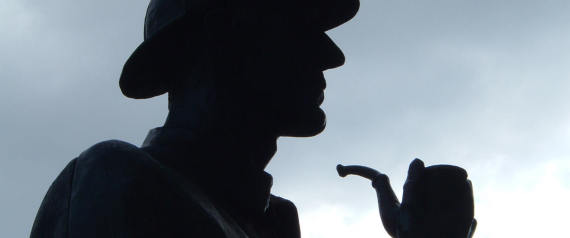
221B Baker Street can be a busy place. Sometimes a fat schoolmaster who just lost a Duke's son faints on the rug. Sherlock Holmes will show up for lunch toting a harpoon under his arm, fresh from spearing pig carcasses. The Prime Minister might drop by to report a crucial state document missing. And there was the time Moriarty's henchmen tried to burn the place down...
Whatever happens, anyone who reads Arthur Conan Doyle (or watches Robert Downey Jr. or Basil Rathbone or Benedict Cumberbatch or any of the dozens of filmic Sherlocks) knows this: day in and day out, Holmes and Dr John Watson always have problems to solve.
As a lifelong Sherlockian, I was pretty sure I knew how he did it. He wields almost super-human observational powers; your suntan can tell him where you've been. (As he says to Watson when they first meet: "You have been in Afghanistan, I perceive.") Sherlock Holmes simply sees what others do not.
But then I wrote a book, The Great Detective, to trace the Baker Street icon's whole history in popular culture, from 1887 to now. As I reread all 60 original stories by Arthur Conan Doyle, I realized that Holmes cracks problems with a method more accessible than I thought. In fact, you could call his approach the Seven-Step Solution.
1. Data, data, data.
The foundation of Sherlock Holmes's approach to problem is observable, discoverable fact. This sounds simple, but it's not: it's human nature to jump to conclusions before one knows anything. (Read any news site's comments threads -- or see how Conan Doyle's average Scotland Yard inspector arrests the first suspicious-seeming character he encounters.) Holmes refuses to bias his judgement before he discovers the facts of a case. In "A Scandal in Bohemia," he lays down the law: "Insensibly one begins to twist facts to suit theories, instead of theories to suit facts."
2. Don't just see -- observe!
In that same story, Holmes asks Watson how many steps lead up to their Baker Street flat. Watson, despite climbing the stairs hundreds of times, has no idea. Sherlock knows: there are seventeen.
3. Talk to people.
Again, this sounds simple. But to a striking degree, Conan Doyle's stories consist of pure dialogue -- they can run along for pages without any other kind of narration. And Sherlock Holmes listens to anyone -- he'll even disguise himself as an out-of-work horse groom to get the boys in the stables to open up.
4. Keep your head.
Holmes finds nothing more exciting than a case. (In fact, when he doesn't have one, he's apt to shoot cocaine to get his kicks.) But he can be amazingly -- annoyingly, even -- calm. In The Hound of the Baskervilles, the entire cast of characters, including Watson, goes cuckoo as strange howls and weird events raise the specter of a demon dog prowling lonely Dartmoor. Is it a blood-thirsty ghost? An ancient curse? Sherlock Holmes, alone, sits back and takes care of mundane, Investigation 101-type chores like checking all the potential suspects' past public records. Which, prosaically enough, solves the case.
5. Take the artist's approach.
Conan Doyle initially based his detective on his old medical-school professor, pioneering physician Joseph Bell. And he loved to dress up his stories with scientific trappings -- Holmes is forever bending over a test tube, proclaiming that he's about to discover a new way to detect bloodstains, or whatever. But when you examine the stories, you discover that science plays a minor role. Instead, Sherlock Holmes is an artist. (Conan Doyle came from a family of famed visual artists, and his father was a talented but frustrated painter.) On a case, Holmes wanders around, noticing odd things on the windowsill or drifting off into reveries about religion and philosophy. He dresses up in funny outfits, or goes to hang out in the local pub for gossip and fistfights. He takes long breaks to go to concerts or eat sandwiches. And whenever he can, Holmes delivers his findings not with a methodical report, but a performative flourish. He smashes a bust of Napoleon to reveal the stolen Black Pearl of the Borgias, or he hides a missing secret treaty in the breakfast dish. In a word, he has fun.
6. Sometimes, just chill out and think.
In "The Man With the Twisted Lip," Holmes and Watson confront a challenging missing-person case: a gentleman vanished from a locked room. It's a fun, atmospheric story, starting with a famous visit to a vile opium den and featuring an assortment of colorful, suspicious characters. But the key scene is just this: Sherlock Holmes makes himself a comfortable nest of pillows, lights his pipe, and thinks. And thinks. He sits thinking all night, without moving, until he hits upon the answer. Somehow, Conan Doyle makes this as interesting as any fight scene, and it's a distinctive Holmesian method. Be still. It'll come to you.
7. Don't just find the answer, find a solution.
Sherlock Holmes always seeks not just a result, but justice. When he entraps a first-time thief in "The Adventure of the Blue Carbuncle," he lets him go with a stern lecture, reasoning that if the man goes to prison, he'll be a criminal for life. (Besides, it's Christmas.) In "The Adventure of the Second Stain," Holmes covers up a crime that nearly starts a Europe-wide war because revealing it would ruin a marriage. The clues the Great Detective finds in his investigations lead him to action -- but he always insists on taking the right action. In the end, this -- as much as his all-seeing eye, his ironclad analytical powers and his taste for strong tobacco -- is what makes him not just a detective, but Sherlock Holmes.
